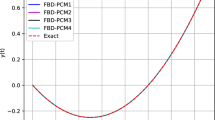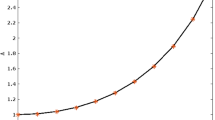Summary
Given a 2 π-periodic functionf, it is desired to approximate itsn-th Fourier coefficientc n (f) in terms of function valuesf μ atN equidistant abscisses
A time-honored procedure consists in interpolatingf at these points by some 2 π-periodic function ϕ and aproximatingc n (f) byc n (ϕ). In a number of cases, where ϕ is piecewise polynomial, it has been known that\(c_n (\varphi ) = \tau _n \hat c_n (f)\) where\(\hat c_n (f)\) is the trapezoidal rule approximation ofc n (f) andτ n is independent off. Our interest is in the factorsτ n , called attenuation factors. We first clarify the conditions on the approximation processP:f→ϕ under which such attenuation factors arise. It turns out that a necessary and sufficient condition is linearity and translation invariance ofP. The latter means that shifting the periodic dataf={f μ } one place to the right has the effect of shifting ϕ=P f by the same amount. An explicit formula forτ n is obtained for any processP which is linear and translation invariant. For interpolation processes it suffices to obtain a factorizationc n (ϕ)=ω(n)ψ f (n), where ω does not depend onf andψ f (n) has periodN. This also implies existence of attenuation factorsτ n , which are expressible in terms of ω. The results can be extended in two directions: First, the processP may also approximate successive derivative valuesf (x) μ , ϰ=0,1,...,k−1, of the functionf, in which case formulas of the type\(c_n (\varphi ) = \sum\limits_{x = 0}^{k - 1} {\tau _{_{n_{,x} } } \hat c} (f^{(x)} )\) emerge. Secondly,P may be translation invariant overr subintervals,r>1, in which case\(c_n (\varphi ) = \sum\limits_{\varrho = 0}^{r - 1} {\tau _{n,\varrho } \hat c_n + \varrho N/} r(f)\). All results are illustrated by a number of examples, in which ϕ are polynomial and nonpolynomial spline interpolants, including deficient splines, as well as other piecewise polynomial interpolants. These include approximants of low, and medium continuity classes permitting arbitrarily high degree of approximation.
Similar content being viewed by others
References
Ahlberg, J. H., Nilson, E. N., Walsh, J. L.: The theory of splines and their application. New York-London: Academic Press 1967.
Bauer, F. L., Stetter, H. J.: Zur numerischen Fourier-Transformation. Numer. Math.1, 208–220 (1959).
Chao, F. H.: A new method of practical harmonic analysis [Chinese]. Acta Math. Sinica6, 433–451 (1956).
Cooley, J. W., Tukey, J. W.: An algorithm for the machine calculation of complex Fourier series. Math. Comp.19, 297–301 (1965).
—, Lewis, P. A. W., Welch, P. D.: The fast Fourier transform and its applications. IEEE Trans. Education E-12, 27–34 (1969).
Dällenbach, W.: Verschärftes rechnerisches Verfahren der harmonischen Analyse. Arch. Elektrotechnik10, 277–282 (1921).
Eagle, A.: On the relations between the Fourier constants of a periodic function and the coefficients determined by harmonic analysis. Philos. Mag.5 (7), 113–132 (1928).
Ehlich, H.: Untersuchungen zur numerischen Fourieranalyse. Math. Z.91, 380–420 (1966).
Gentleman, W. M., Sande, G.: Fast Fourier transforms-for fun and profit, 1966 Fall Joint Computer Conference, AFIPS Proc., vol. 29. Washington D. C.: Spartan 1966.
Golomb, M.: Approximation by periodic spline interpolants on uniform meshes. J. Approximation Theory1, 26–65 (1968).
Hildebrand, F. B.: Introduction to numerical analysis. New York: McGraw-Hill 1956.
Oumoff, N.: Sur l'application de la méthode de Mr. Ludimar Hermann à l'analyse des courbes périodiques. Le Physiologiste Russe1, 52–64 (1898/99).
Quade, W., Collatz, L.: Zur Interpolationstheorie der reellen periodischen Funktionen. Sitzungsber. Preuss. Akad. Wiss.30, 383–429 (1938).
Runge, C.: Theorie und Praxis der Reihen. Leipzig: G. J. Göschen'sche Verlagshandlung 1904.
Salzer, H. E.: Formulas for calculating Fourier coefficients. J. Math. Phys.36, 96–98 (1957).
Schoenberg, I. J.: On spline interpolation at all integer points of the real axis. Colloquium on the Theory of Approximation of Functions (Cluj, 1967). Mathematica (Cluj)10 (33), 151–170 (1968).
Schweikert, D. G.: An interpolation curve using a spline in tension. J. Math. and Phys.45, 312–317 (1966).
Serebrennikov, M. G.: A more exact method of harmonic analysis of empirical periodic curves [Russian]. Akad. Nauk SSSR. Prikl. Mat. Meh.12, 227–232 (1948).
Yuškov, P. P.: The practical harmonic analysis of empirical functions when the given curve is replaced by another approximating the given one by tracing [Russian]. Akad. Nauk SSSR. Inž. Sbornik6, 197–210 (1950).
—: On the correction of the coefficients obtained in the usual practical harmonic analysis [Russian]. Akad. Nauk SSSR. Inž. Sbornik10, 213–222 (1951).
Author information
Authors and Affiliations
Additional information
This work was carried out while the author was Visiting Professor at the Mathematical Institute of the Technical University of Munich, Germany. The work was supported in part by a Fulbright research grant.
Rights and permissions
About this article
Cite this article
Gautschi, W. Attenuation factors in practical Fourier analysis. Numer. Math. 18, 373–400 (1971). https://doi.org/10.1007/BF01406676
Received:
Issue Date:
DOI: https://doi.org/10.1007/BF01406676




